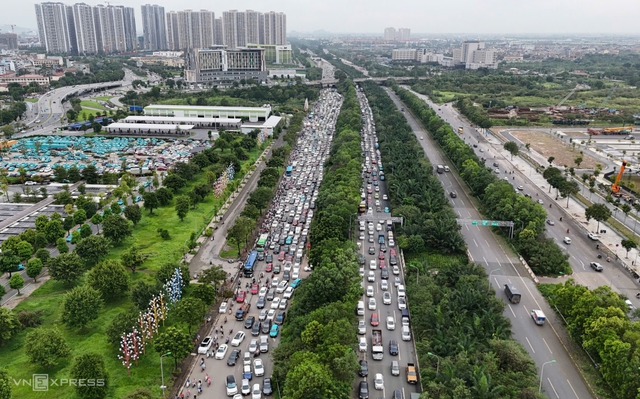Capital plans to restrict polluting vehicles in populated areas from 2025
VGP - Ha Noi will trial a low-emission zone (LEZ) model from 2025, restricting polluting vehicles in densely populated areas, city officials said.

The boulevard suffers a long tailback on the direction leading to Ha Noi center - Photo: Vnexpress
The local authorities are seeking public opinions for a draft resolution that would create a low-emission zone model from 2025 by restricting polluting vehicles in densely populated areas.
Its ultimate goal is to gradually restrict motorbike use in the designated areas, paving the way for a complete motorbike ban in the inner city by 2030.
The city will pilot low-emission zones in air pollution hotspots starting in 2025, where polluting vehicles will be restricted. More investment will be poured into public transport development including metro lines and bus rapid transit routes.
According to the draft, an low emission zones (LEZ) is a restricted area within the city where air pollution levels are high. Vehicles operating in these zones must meet strict emission standards, with non-compliant vehicles facing restrictions or additional fees.
Ha Noi has proposed five regions for implementing traffic restrictions to limit pollution.
The first category includes areas with high economic, cultural, and social development; densely populated regions with important heritage sites, and areas with potential for cultural and social tourism.
The second category targets regions experiencing air pollution primarily due to traffic emissions.
The third area encompasses locations with infrastructure that supports low-emission public transport, where traffic can be organized efficiently and scientifically.
The fourth area includes zones that are equipped to enforce stricter emission standards for vehicles.
Finally, the fifth category consists of areas where both local authorities and residents are supportive of establishing low emission zones.
Designated LEZs will adopt various traffic and economic measures to reduce air pollution. Ha Noi plans to gradually restrict motorbike use in these areas, with the goal of phasing out motorbikes in central districts by 2030, as per a 2017 resolution by the city’s People’s Council.
The city will also introduce policies to replace old motorbikes that fail to meet safety and emission standards, designate zones where diesel vehicles are restricted, and encourage the replacement of diesel buses with electric alternatives.
Vehicle emissions – main causes of air pollution
Le Thanh Nam, director of the city's Department of Natural Resources and Environment said Ha Noi, with its 17 industrial complexes, 1,300 craft villages and 8 million motorbikes and cars, consumes approximately 80 million kWh of electricity and millions of liters of gasoline daily.
"This is one of many causes of air pollution," Nam said, explaining that the city is implementing certain main solutions to address the issue: cleaning up lakes and rivers, expanding automatic air and water quality monitoring systems, utilizing green energy, developing smart cities and traffic systems, and creating more green spaces in urban areas.
Starting in 2025, low-emission zones will be trialed in air pollution hotspots, where high-polluting vehicles will be restricted. Nam added that routes exclusively for electric buses and low-emission vehicles may also be developed, alongside the expansion of public transport options.
Nguyen Phi Thuong, Director of the Ha Noi's Department of Transport, reported that of the 8 million vehicles, 1.2 million are cars, with personal vehicle numbers rising by 4-5 percent annually, and cars by 10 percent each year. In contrast, the city's infrastructure grows by only 0.28 percent annually.
Ha Noi's land allocated for traffic is currently 12 percent, below the target of at least 16 percent. This shortfall leads to vehicles exceeding road capacity, contributing to the city's 33 traffic congestion hotspots, Thuong said.
Investing in urban railways has been proposed as a solution. While Ha Noi initially planned for 10 railway routes spanning 417 km, this has been revised to 14 routes totaling 600 km. However, construction could take 15-20 years and cost around US$100 million per kilometer, translating to an estimated US$50 billion for 600 km, Thuong said.
The city's statistics indicate that Ha Noi's PM2.5 levels from 2018-2020 were double the national standard of 25 µg per cubic meter. Transportation is the largest contributor, accounting for 50-70 percent of PM2.5 emissions./.

